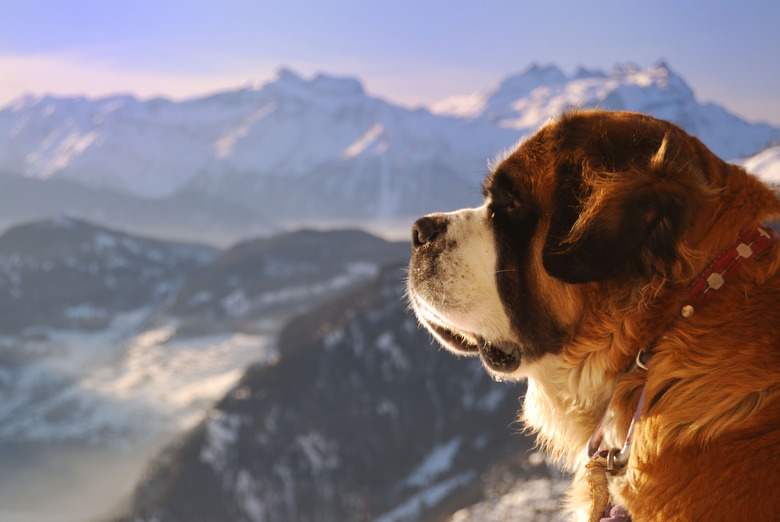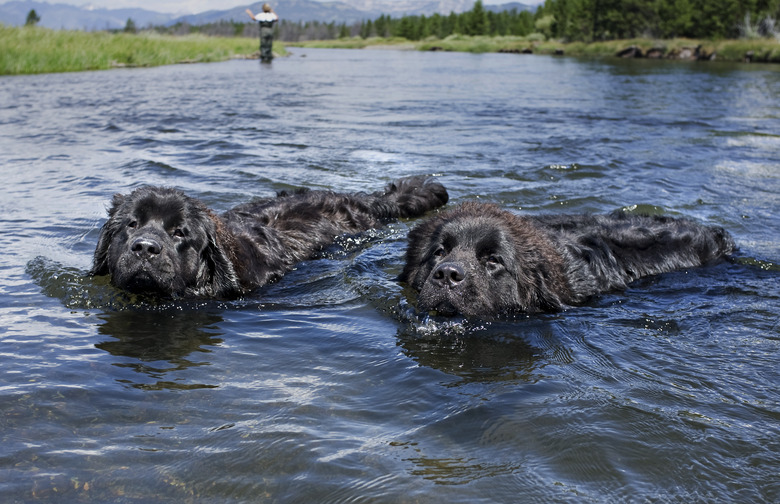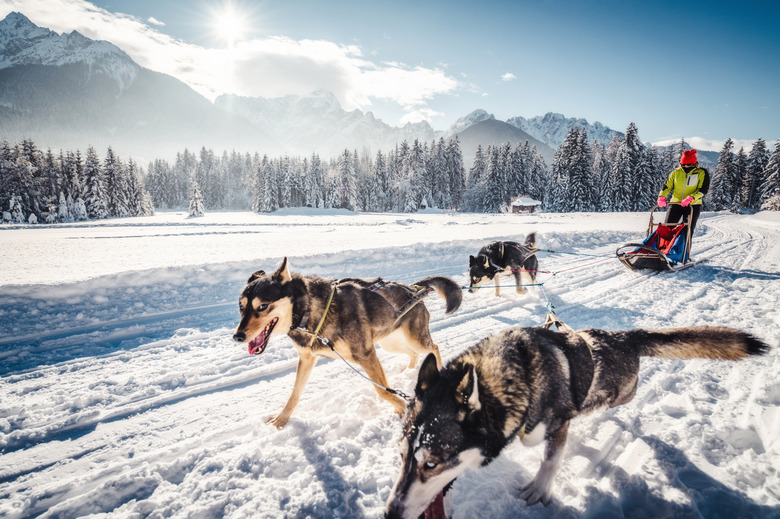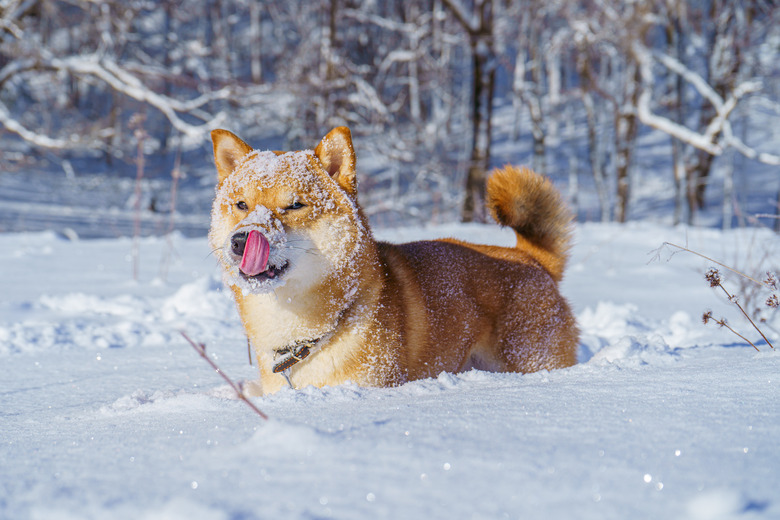8 Fun Facts About Dog Breeds Who Thrive In Cold Weather
- Saint Bernards were bred for mountain rescues
- Newfoundlands sailed the world as rescue dogs
- Sled dogs have been around for over 30,000 years
- Sled dogs helped save a town from a deadly virus
- The Norwegian elkhound was a beloved Viking companion
- Norwegian elkhounds don't actually hunt elk
- Shiba Inus are tiny snow dogs
- Tibetan terriers have snowshoe paws
While some dogs might go on a walking strike when temperatures drop, others thrive in cold climates. From sled dogs to guard dogs, these cold weather dog breeds aren't phased by Arctic temperatures.
1. Saint Bernards were bred for cold weather mountain rescues
1. Saint Bernards were bred for cold weather mountain rescues
In 1050, a monastery and hospice was established for travelers along the dangerous mountain pass between Italy and Switzerland. Monks living there brought in several dogs as watchdogs and companions. These dogs had a keen ability to detect impending avalanches. So they began to accompany monks on the treacherous mountain footpaths.
By 1750, these hardy dogs were known as Saint Bernards and had begun to accompany travelers through the Swiss Alps. With their strong sense of smell, they could find people who had become lost in the snow and were sent out in small teams to rescue lost or injured travelers. They would locate the person and dig them out of the snow. One dog would head back to the monastery to bring help, while the other dogs would lie on or around the injured person to keep them warm.
2. Newfoundlands sailed the world as rescue dogs
2. Newfoundlands sailed the world as rescue dogs
In the 1600s, English fishermen visiting the island of Newfoundland (off the east coast of what is now Canada) were impressed by the large dogs they found there. Newfies' physical traits make them perfect for water rescue: webbed feet help them paddle, a strong tail acts as a rudder, and their double coat repels water and keeps them warm.
From the 1700s through the 1800s, Newfoundland dogs served as important crew members on sailing ships. In fact, a Newfoundland named Seaman traveled with Lewis and Clark on their Corps of Discovery expedition. These gentle giants are credited with saving hundreds of lives over the years by rescuing people from drowning and even towing small boats safely back to shore.
3. Sled dogs have been around for over 30,000 years
3. Sled dogs have been around for over 30,000 years
Several dog breeds who excel at pulling sleds have long lineages. Ancient breeds such as the Siberian husky, Alaskan Malamute, Samoyed, and Chinook are thought to have originated in Mongolia between 35,000 and 30,000 years ago.
Siberian huskies were developed and bred by the Chukchi people of the Chukchi peninsula of eastern Siberia. This breed is a loyal companion and devoted working dog. Their thick double coats keep them safe in freezing temperatures — they can withstand weather down to about 10 degrees Fahrenheit. While Huskies can tolerate winter weather due to their thick fur, they do get cold and should not be left outside in winter.
4. Sled dogs helped save a town from a deadly virus
4. Sled dogs helped save a town from a deadly virus
In the winter of 1925, a deadly diphtheria outbreak threatened the remote town of Nome, Alaska. The nearest supply of antitoxin was in Nenana, 674 miles away. Due to an impending blizzard, officials determined the fastest way to deliver the antitoxin was via sled dogs.
A relay of 20 sled dog teams was organized, and the "Great Race of Mercy" was completed in five and a half days. Two Siberian Huskies, Balto and Togo, played vital roles in delivering the life-saving serum to the remote town. Balto was the lead dog in the final 53-mile leg of the journey, while Togo and his musher Leonhard Seppala traveled a grueling 264 miles together.
5. The Norwegian elkhound was a beloved Viking companion
5. The Norwegian elkhound was a beloved Viking companion
Another ancient breed, the Norwegian elkhound is descended from the northern Spitz family of dogs that are considered one of the oldest breeds of domesticated dogs.
Archaeologists have discovered elkhound remains in Viking graves. Buried with their owners and placed alongside shields and swords, this breed played an important role in Viking culture.
6. Norwegian elkhounds don't actually hunt elk
6. Norwegian elkhounds don't actually hunt elk
Their name is a bit of a misnomer — "elg" means "moose" and "hund" means "dog" in Norwegian. Technically, they're more of a moose dog as they were bred to track large game like moose and bears.
7. Shiba Inus are tiny snow dogs
7. Shiba Inus are tiny snow dogs
Native to Japan, the Shiba Inu was originally bred as a hunting dog. With their soft, dense undercoats and thick outer coats, they easily rival larger breeds when it comes to cold temperatures. Weighing in at around 20 pounds, this friendly, high-energy breed is also popular as a family pet.
8. Tibetan terriers have snowshoe paws
8. Tibetan terriers have snowshoe paws
At just over a foot tall, you might not pick the Tibetan terrier to join your mountaineering team — but you'd be wise to do so. This ancient breed has served as a watchdog and companion in their native Tibet for thousands of years. Weighing an average of just 22 pounds, Tibetan terriers are equipped with a dense coat and large, flat paws that function like snowshoes — helping them to cross the snow for centuries.
References
- American Kennel Club: Togo – Siberian Husky and Sled Dog Hero of the 1925 Nome Serum Run
- American Kennel Club: Sled Dog Breeds – From Arctic Exploration to the Iditarod
- American Kennel Club: The Rescuers – Breeds Who Save Lives
- Washington Post: Meet the Avalanche Dogs Who Save Skiers' Lives
- American Kennel Club: 5 Things You Didn't Know About the Norwegian Elkhound
- American Kennel Club: Shiba Inu Dog Breed Information
- American Kennel Club: Tibetan Terrier Dog Breed Information



